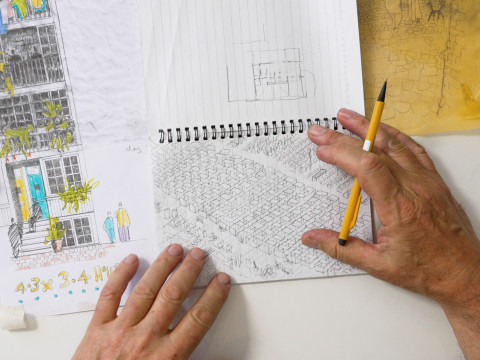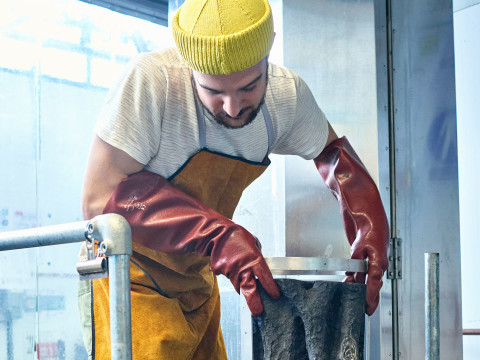
Pezo Von Ellrichshausen: to the Pacific edge
By Kate Goodwin
Published on 5 December 2013
Curator Kate Goodwin visits a "heroic" house perched high, overlooking the ocean in Chile.
Despite using similar raw materials and geometric forms to Casa Cien (their home and studio), Pezo von Ellrichshausen’s Casa Poli feels quite different. Perched on a spectacular piece of land that sits astride a small peninsular in the Pacific Ocean, its placement is the result of very careful consideration.
It is positioned so the slope falls away gently enough to make it feel securely anchored to the ground, but also perched on the edge between land and the expanse of sea. When I first arrived, looking down on it from a distance it felt almost austere, and drew to mind concrete observation lookouts defending against invasion.
However, the cubic form also feels eternal, particularly as you draw closer and discover the lichen growing on its concrete surface.


It feels almost heroic – man and nature, united in ambition. However, the greatest surprise came from spending time within it. To describe its interior as a perimeter space between two walls, containing stairs, service and storage belies its magic. Large windows penetrate the walls and the depth is used to really grab hold of the view and bring it inside. An interior is created that has an expansive character. The walls enclose a volume, not rooms. It thus evokes a feeling of a world neither inside nor out. Light moves through the house like another occupant, bringing warm colour to one corner, bright outlines to another, animating the house on a minute-by-minute basis.

We sat all afternoon in the house, discussing yet more ideas, which were able to flow and change just as did the light and mood of the space. As I walked away the next morning, looking back down on the house that I’d first seen only the day before, it looked entirely different.
What had at first seemed a definitive object now appeared alive- both in its setting and what I knew it to contain. It reinforced more than ever how a building needs to be experienced, inhabited and spent time with to properly digest, consider and enjoy.

A snippet from our meandering afternoon conversation
Kate: How can we bring to the fore the qualities of architecture: make it – and people – ‘present’ within a gallery space?
Sofia: I think what we’re talking about here is about an interaction. We should generate some sort of interaction between the visitor and this inanimate ‘thing’ that is architecture, and not with a show made by other people, because then architecture just becomes a backdrop. It should be active, but what is the interaction about?
Mauricio: To touch, to smell, to see some details, to walk in a special way… the way you walk around a staircase like here, you’re having a bodily connection with the building; you touch the building; you’re making an effort…
S: Your heart beats faster.
M: Your muscles are different… by forcing someone to have an effect on their body you’re dismissing the possibility of being in a place without doing anything which is what architecture normally does. I think it’s an important definition. Architecture is a structure that you cannot see directly; it’s peripheral to your view. That’s architecture. And the tendency today is to make it the central focus of your attention. When you go to a museum and you see a painting hanging on a wall… that’s the centre focus of my attention. Architecture is not trying to do that, except for maybe a church where you have the altar or specific monuments… but normal architecture is secondary, invisible… or lateral.
S: Good architecture is somehow invisible, but allows for whatever is happening in that space to be the best experience possible. But it’s true that now as we’re sitting in this space, we’re not directly interacting with the architecture of the building, but it is what is allowing for the condition of the light, and a very nice breeze…





